About the Africa Entertainment and Media Outlook 2024-2028 publication
PwC’s Africa Entertainment and Media Outlook 2024–2028 provides a compass for entertainment and media (E&M) leaders as they navigate the coming years.
As E&M companies reinvent their business models, they must understand precisely where—in which regions and in which subsectors—new pools of revenues will form. Our 13th annual Outlook offers an in-depth look at the drivers and inhibitors of E&M sector growth, as well as the latest trends and insights set to shape the African E&M market across South Africa, Nigeria and Kenya over the next five years.
Each year, we gather, examine and question a deep collection of proprietary entertainment and media industry data and forecasts. Following this, our global team of experts from more than a dozen countries discuss and debate the trends we see in the market, in our client work and in our daily lives. Finally, we do a deep dive into Africa-specific trends, investigating the future of the E&M industry on the continent. The result is a unique body of intelligence and foresight that companies and investors can consider as they plot strategy and action.
Executive summary
Resilience and reinvention
South Africa, Kenya and Nigeria’s E&M markets are showing resilience against a backdrop of global macroeconomic instability. All three African markets saw revenue growth ahead of the global average of 5.0% in 2023. Growth was strongest in Nigeria, at 15.0%, while South Africa and Kenya saw increases of 11.7% and 5.8% respectively.
Over the next five years, E&M revenues in all three markets are expected to rise ahead of the global average of a 3.9% CAGR. E&M revenue in South Africa will increase from R295.3bn (US$16.1bn) to R363.2bn (US$19.8bn). In Nigeria, the market value will grow from US$9.0bn in 2023 to US$13.6bn in 2028, while revenue will reach US$4.8bn in Kenya at the end of the forecast period, up from US$3.8bn in 2023.
Some segments in these territories, such as live music, have finally recovered to surpass pre-COVID revenue levels. Other sectors, like internet advertising, are achieving impressive scale, while ongoing infrastructure deployments and rapid growth in data usage will fuel demand and drive fixed and mobile service revenue growth.
Linear value chains are disaggregating in favour of digital ecosystems. The global content boom from streaming growth has stalled. Generative artificial intelligence (genAI) promises efficiency and productivity gains, while also disrupting business models across and between multiple industries. It all adds up to widespread uncertainty and a growing imperative for business model reinvention. PwC’s 27th Annual CEO Survey reveals 57% of E&M CEOs, versus 45% of all CEOs, believe their current business model won’t be viable in ten years.
Going forward, emerging technologies will continue to disrupt and transform E&M. AI is set to significantly impact the industry by enhancing content creation, recommendation and production processes. GenAI can quickly convert ideas into images, stories or scripts, while AI-powered analytics will drive production choices and improve user experiences. Technical advances like network optimisation and automated customer support can reduce costs.
Meanwhile, the 5G rollout is continuing in Africa and 5G E&M use cases for the technology span areas such as cloud gaming, video streaming and VR. Africa has a younger population compared to many other regions. This demographic is more inclined towards digital and mobile platforms, driving growth in sectors like mobile gaming, esports and over-the-top streaming (OTT) services.
Market highlights
- South Africa: The most established market, with a projected CAGR of 4.2% through 2028. Growth is expected across all segments other than print media. OTT and internet advertising will see some of the highest growth rates, supported by stable internet connectivity and 5G adoption. Video games and esports remain a segment to watch, promising promising strong future growth.
- Nigeria: Is one of the fastest-growing E&M markets globally, with an 8.6% CAGR. The fastest-growing E&M segments through 2028 in Nigeria include internet advertising, video games and esports, OTT and music, radio and podcasts. Internet advertising revenue is expected to more than double between 2023 and 2028.
- Kenya: Total E&M market expected to grow at a 5.2% CAGR, with internet advertising and OTT leading the way. Kenya’s internet advertising market is projected to be the fastest growing in the world at a CAGR of 17.4%.
Segment highlights
Mobile-first connectivity
Unlike many global markets where fixed broadband is prevalent, Africa’s E&M growth is primarily driven by mobile services due to low fixed broadband penetration. The expansion of 4G and 5G networks is crucial for connectivity, with mobile subscriptions significantly outpacing fixed broadband. South Africa and Kenya will reach a tipping point where 4G subscriptions overtake 3G by the end of 2024, while in Nigeria, this is expected by 2026. Consequently, Africa lags one technological generation behind the global trend, where 5G is expected to overtake 4G by 2027.
In line with global trends, video leads as the largest content category in South Africa, taking an 82.2% share of all data consumed. Social video is the main growth driver within the video sector, with platforms like TikTok and Instagram growing in popularity in the market. In Nigeria, games also make up a significant share of data consumed.
Real-life experiences rebound, connected digital services continue growth
E&M is a realm in which real-life, in-person, increasingly tech-enabled experiences—music performances, theatre, cinema, sports and more—matter a great deal. Live music and events are rebounding strongly post-COVID (a trend seen both globally and in Africa), with notable performances and festivals across the continent.
Despite challenging market conditions, the OTT market in Africa is still growing, with significant investments in infrastructure and content. The number of OTT subscriptions is projected to increase despite recent subscription price increases and the removal of free subscription tiers. South Africa is set to add nearly 1.6 million additional OTT subscribers by the end of 2028.
The global shift towards digital and mobile platforms is reflected in Africa: mobile gaming dominates, with fast-paced growth in esports. Uniquely, Kenya’s traditional gaming revenues still exceed mobile in 2023 and will retain their lead throughout the forecast period.
Rapid growth in internet advertising
While internet advertising is growing globally, Africa—particularly Nigeria and Kenya—is experiencing exceptionally high growth rates. This is driven by increasing Internet penetration and the adoption of digital platforms. Globally, advertising is projected to account for a significant portion of E&M industry growth. Internet advertising is set to lead ad spend, with AI and retail search influencing the segment. Retail search advertising accounted for 27.3% of paid search revenue in Nigeria in 2023, driven by a strong local e-commerce sector.
Key report findings
South Africa
Figure 1a: Total E&M revenue in South Africa expected to eclipse R360 bn by 2028
South Africa, entertainment and media spend by segment, 2019-2028 (R mn)
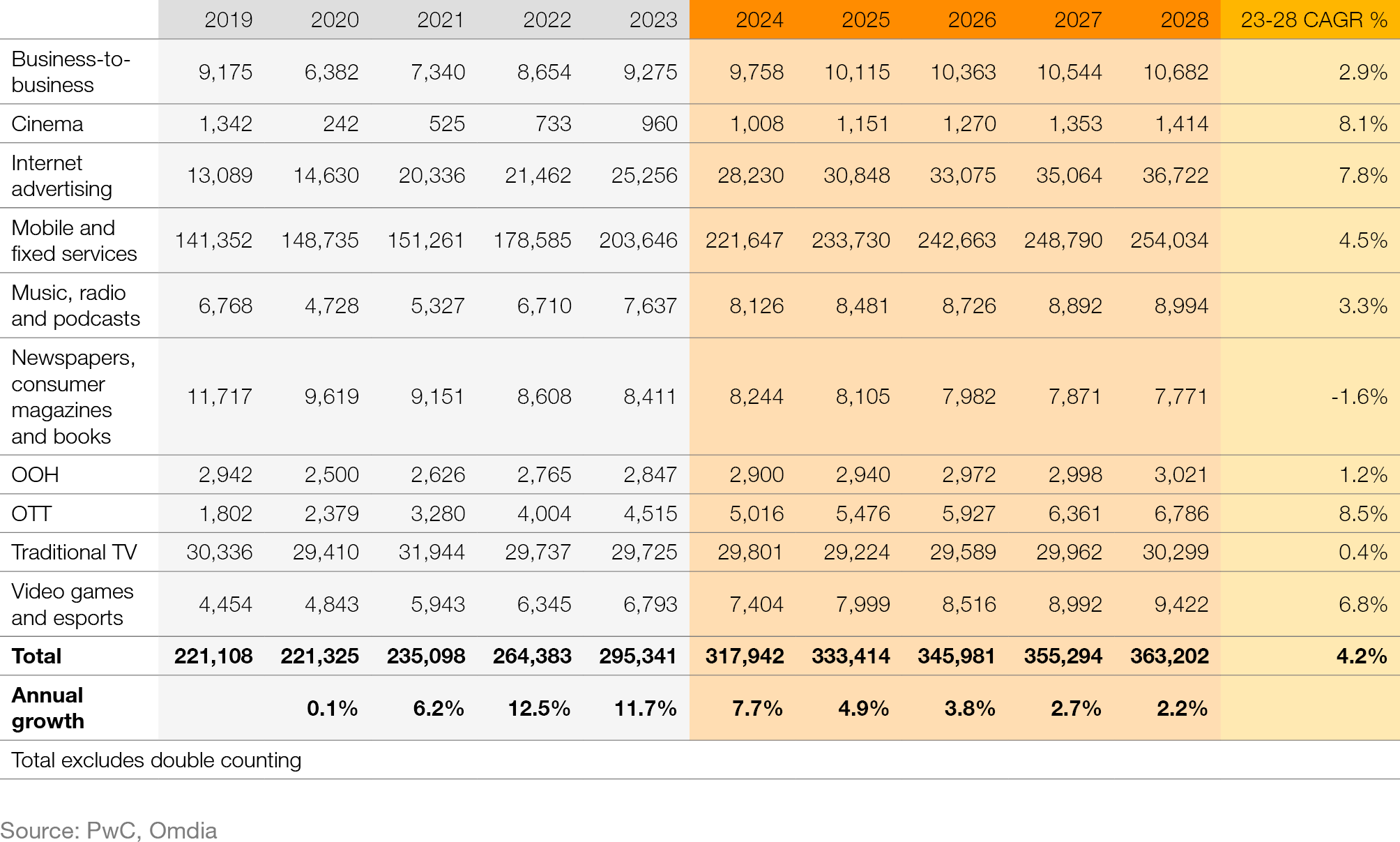
South Africa is the most well-established E&M market compared to Nigeria and Kenya and will therefore see the slowest growth over the forecast period, at an overall CAGR of 4.2%. Growth is expected across all segments aside from newspapers, consumer magazines and books, which is a segment that is also seeing declines in many other global markets due to its reliance on print.
OTT, cinema and internet advertising are expected to be the fastest-growing metrics but for very different reasons. Ongoing infrastructure development and greater 5G adoption will help improve connective stability, fuelling growth in OTT and internet advertising. International blockbusters will help drive the cinema industry in South Africa, which has been experiencing a challenging few years and is starting to show steady recovery to pre-pandemic revenues by 2027.

“South Africa’s resilient E&M market will see significant growth in OTT and internet advertising, driven by stable connectivity and 5G adoption, but must adapt to business model reinvention amidst digital ecosystem shifts and AI disruptions.”
Nigeria
Figure 1b: Nigeria continues to boast one of the fastest-growing E&M industries in the world
Nigeria, entertainment and media spend by segment, 2019-28 (US$ mn)
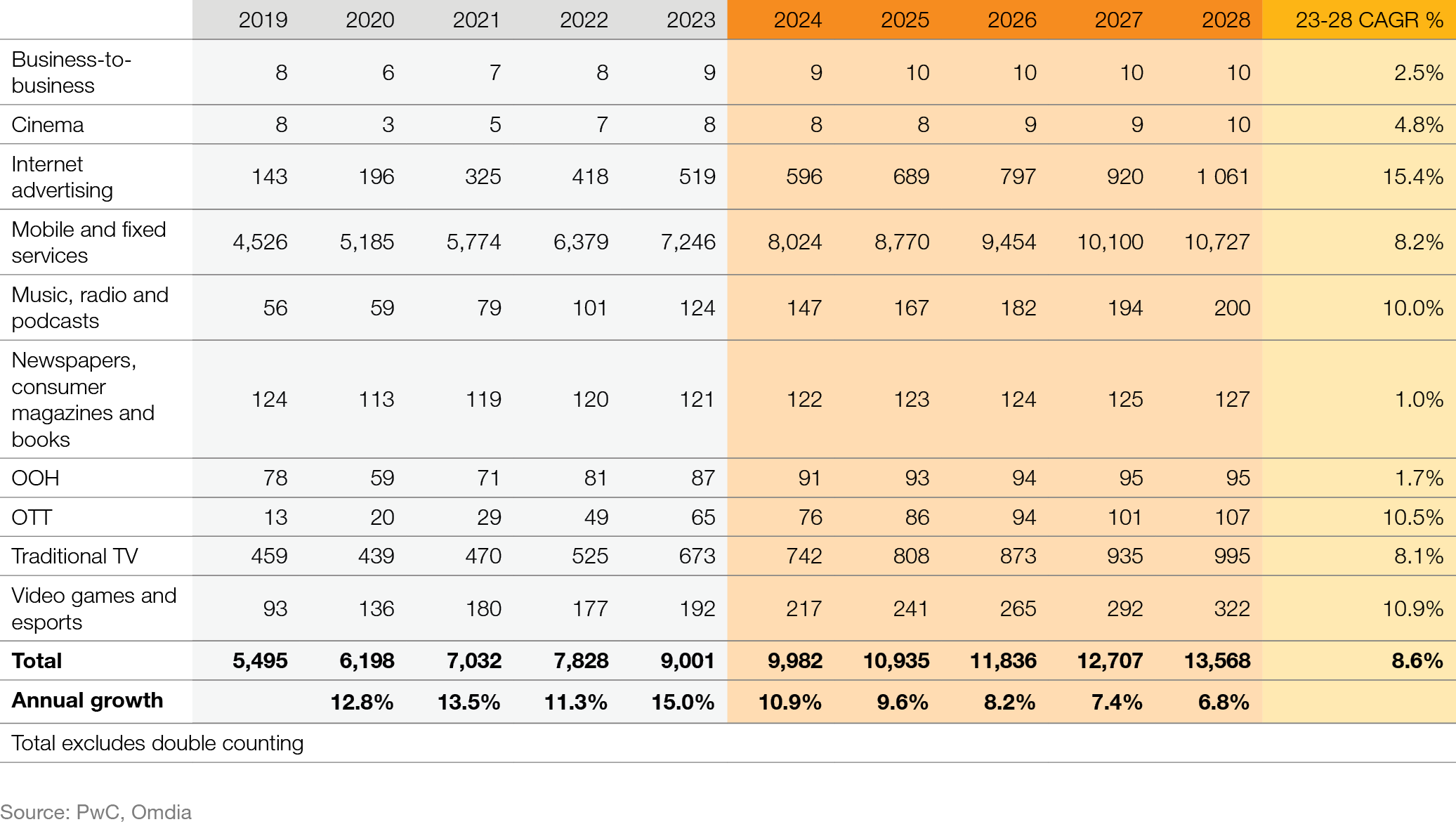
Nigeria has one of the fastest-growing E&M industries, driven by its population of over 230 million, with a median age of 18.1 years. This predominantly young demographic represents significant consumer potential for the E&M sector. Additionally, government investments aimed at expanding its footprint across various industries further contribute to this impressive growth rate. It is widely acknowledged as Africa’s leading E&M hub, home to the world-renowned Nollywood movie industry, which produces around 2,500 films annually. Nigeria will see the fastest growth over the forecast period, compared to South Africa and Kenya, at an 8.6% CAGR.
The fastest-growing E&M segments through 2028 include internet advertising, video games and esports, OTT, and music, radio and podcasts. Internet advertising revenue is expected to more than double between 2023 and 2028, which will be fuelled by Nigeria’s broadband plan that aims to provide effective broadband coverage to 90% of the population by the end of 2025.

“With a youthful population eager to embrace innovation, Nigeria's entertainment and media industry can harness the power of genAI to capitalise on this disruptive force, unlocking new opportunities for growth and development.”
Kenya
Figure 1c: Total E&M revenue in Kenya expected to reach US$4.8 bn by 2028
Kenya, entertainment and media spend by segment, 2019-28 (US$ m)
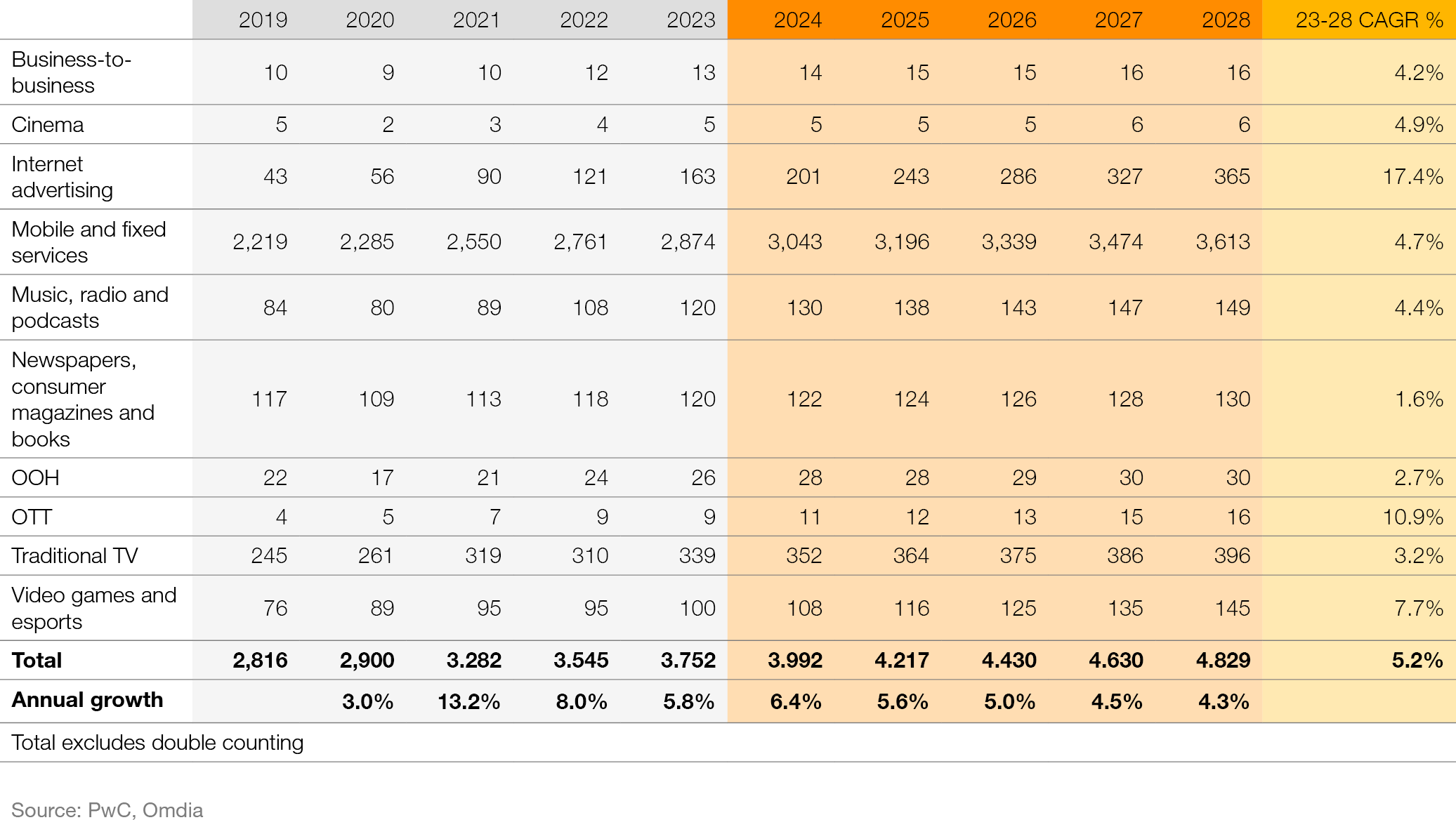
Kenya remains the smallest of the three markets but will see solid growth of a 5.2% CAGR over the forecast period. All segments will see increases through 2028, with internet advertising and OTT expected to be the fastest. Kenya is expected to have the fastest growing internet advertising market in the world between 2023 and 2028, with an increase at a 17.4% CAGR pushing total revenue from US$163mn to US$365mn.

“Kenya’s E&M industry is poised for remarkable growth, with the world’s fastest-growing internet advertising market and a leading position in mobile game spending driven by rising smartphone accessibility.”
Connectivity
The connectivity category is the largest contributor to the E&M industry globally and in Africa. Fixed broadband penetration rates are very low across the markets covered. In Nigeria, less than 5.0% of households have a subscription to fixed broadband, while penetration is at just 10.4% in Kenya and 46.3% in South Africa.
Growth is, therefore, coming from the mobile sector, which is supported by consumers continuing to adopt 4G packages and the expansion of the 5G rollout. Both South Africa and Kenya will experience a key tipping point by the end of 2024, when the number of 4G subscriptions will overtake 3G. Nigeria will lag these two markets, reaching this tipping point in 2026. Globally, 4G has led the mobile market for several years and 5G is expected to overtake this category in 2027.
Figure 2: 4G subscriptions to overtake 3G by end 2024 in South Africa and Kenya
South Africa and Kenya, mobile subscriptions split by type, 2019-2028 (mn)
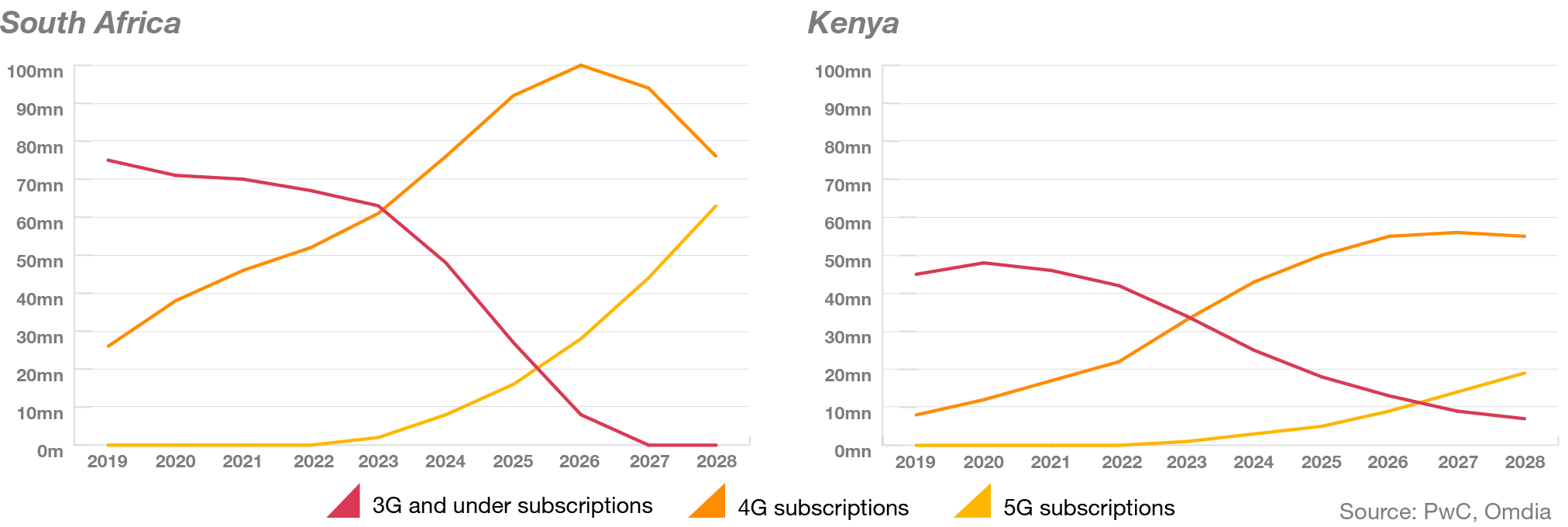
In September 2024, Vodacom South Africa introduced a cloud-based phone to reduce the cost of smartphone access in the country and accelerate the migration of customers from legacy networks to modern 4G networks. The new cloud-based phone combines cloud computing and a range of features typically associated with entry-level smartphones at a more affordable price. Popular applications such as YouTube, TikTok and Facebook come as standard with the cloud-based phone, all accessed via the cloud, giving users a “smartphone lite” experience at a retail price of just R249 (US$14).
Mobile handsets account for the largest share of data consumption in both Nigeria and South Africa, while Wi-Fi leads as the most popular network. In line with global trends, video leads as the largest content category in South Africa, taking an 82.2% share of all data consumed. Social video is the main growth driver within the video sector, with platforms like TikTok and Instagram growing in popularity in the market. While video also leads in Nigeria, the picture differs somewhat from the global average, with games and communications accounting for more of total consumption, leaving video with a 45.2% share in 2023.
Figure 3: Video projected to account for the majority of data consumption in South Africa
South Africa, data consumption split by content type, 2028 (PB)
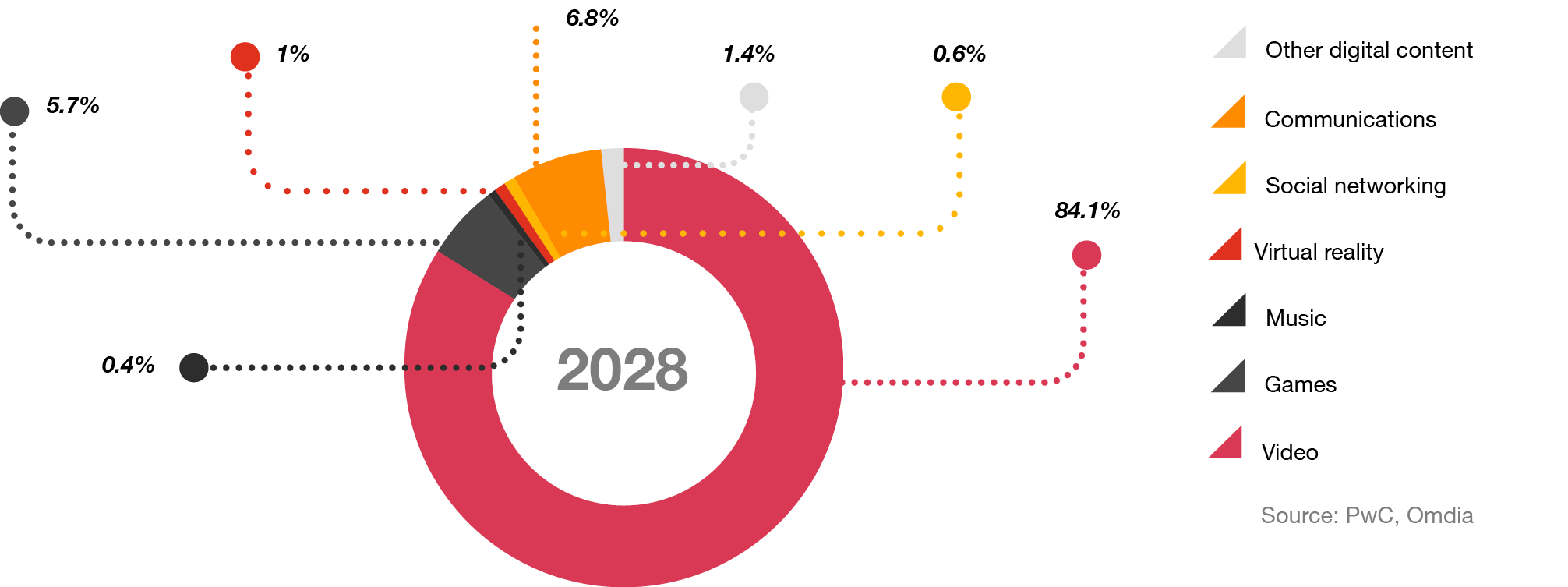
Consumer spending
African gaming and esports primed for future growth
South Africa remains the largest video games and esports market in Africa ahead of Nigeria and Kenya, although the continent lags other global regions. Much of Africa is focused on mobile gaming, with console and PC setups being less accessible to consumers than in North America and Europe. However, in recent years, efforts have been made in South Africa to support the PC gaming scene, with video game publisher Carry1st partnering with Riot Games to launch local Valorant servers in August 2023. The partnership also included running player engagement campaigns in various South African cities. This international expansion was not the first example of its kind, with China having seen a similar launch months earlier to significant success.
Ongoing efforts have also been made in Nigeria to develop a more rigorous esports structure, with governing bodies such as the Nigerian eSports Federation and Lagos eSports becoming involved in both local and national tournaments. Online platforms such as Gamr and Richiez Games Entertainment have also been launched in Nigeria to support tournaments. Uniquely, Kenya remains the only African market in which revenue from traditional gaming exceeds social/casual gaming. Improving connectivity and increasing smartphone accessibility will see social/casual gaming close the gap through to 2028.
Live events continue rebound from COVID-19
2023 was a strong year for live music across African countries. In particular, South Africa saw a number of notable performances from globally recognised artists including Imagine Dragons, Sting, Counting Crows and UB40. Additionally, 2023 also saw the hosting of the World New Music Days by the International Society of Contemporary Music in Africa for the first time, with events held in Cape Town, Johannesburg, Soweto and nearby areas. 2023 also saw Nigeria and Kenya reach their highest ever live music ticket sales revenues, officially surpassing pre-COVID levels.
Live music continues to perform well across the African continent. South Africa saw the presence of both Maroon 5 and Keane at Calabash, one of the largest music festivals in the nation, in February 2024. American band Train also toured the country in May, while British band Take That and Chris Brown performed in South Africa in October and December 2024. Nigeria also maintains a vibrant live music scene year-round, with annual festivals including Felabration drawing large crowds.
The 2024 edition saw performances from a variety of prominent Nigerian artists including Bella Shmurda, Skales, May D and Durella. Kenya’s live music growth trajectory remains positive despite challenges in recent years with securing major artists and the lack of viable venues. However, 2024 saw the inaugural version of the Sailing Music Festival, which featured performances from a variety of Kenyan performers.
South Africa recorded the largest annual jump in box office revenue of the three countries during 2023 at 33.6%. South Africa’s 2023 box office charts were dominated by widely successful Hollywood blockbusters such as Barbie, Oppenheimer, Fast X, Mission: Impossible – Dead Reckoning Part One, John Wick Chapter 4 and Aquaman and the Lost Kingdom. Conversely, domestic films made almost no imprint on the South African box office, with only Headspace featuring in the country’s 50 highest-grossing films in the year. A similar picture appears to be unfolding in 2024 in South Africa, with the most popular films all being international exports.
Figure 4: Box office growth set to slow as post-COVID rebound passes
Global vs selected African markets, box office revenue, annual growth, 2020-2028 (%)
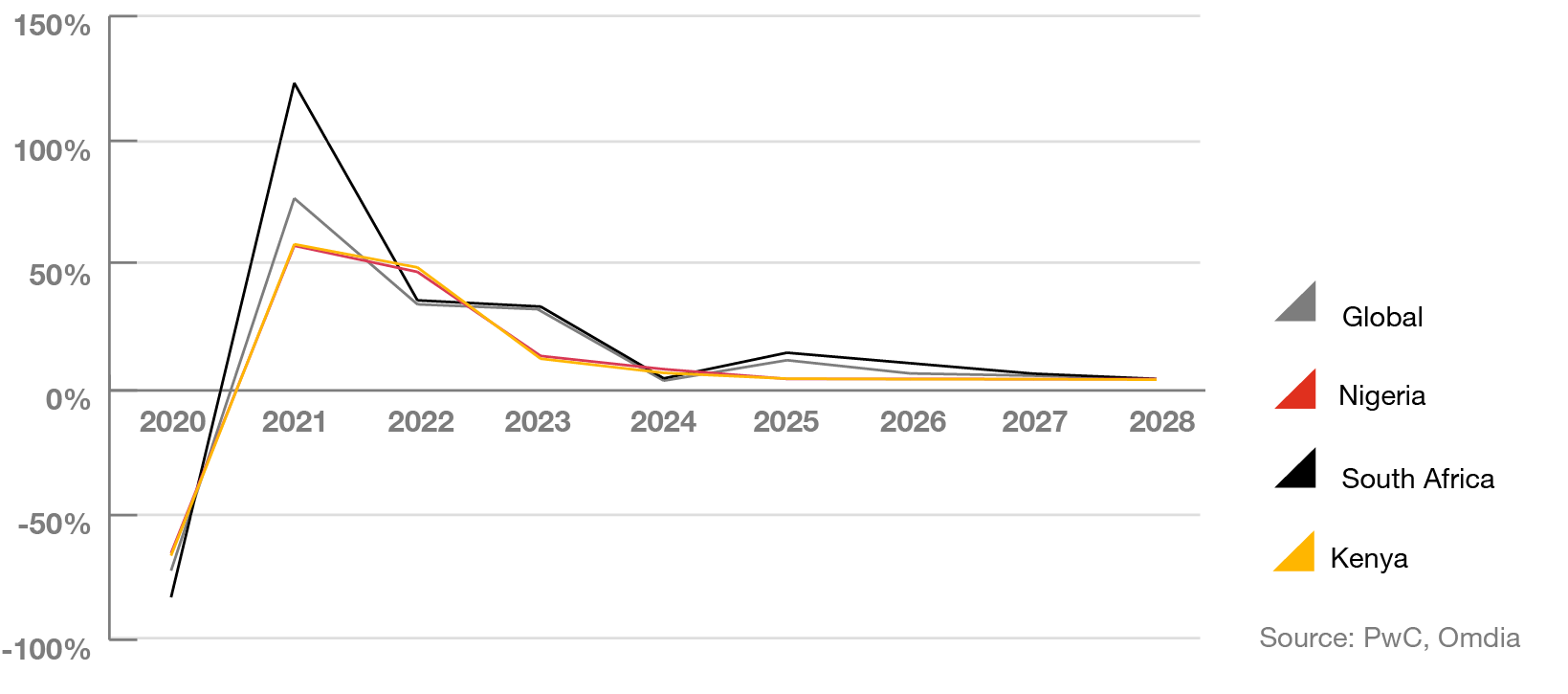
TV and video providers invest in Africa despite challenging climate
Africa’s pay-TV¹ landscape is concentrated, with further consolidation anticipated as Canal+’s acquisition of MultiChoice awaits approval from South Africa’s Competition Tribunal. This market dynamic is a result of significant barriers to entry from high regulatory and licensing costs, slow digital infrastructure rollout, high upfront customer acquisition costs and the limited availability of premium content, which is out of financial reach for many upstart operators.
Economic headwinds in Nigeria led MultiChoice to raise subscription prices on a number occasions in 2023 and 2024. In South Africa, consumers have dealt with persistent power blackouts due to load shedding, which MultiChoice noted had discouraged customers without backup power sources from renewing their subscriptions.
These challenging market conditions have also impacted the OTT sector in Africa. In April 2024, Netflix announced price increases in Nigeria, citing inflationary pressures resulting from a weakening Naira. South Africa, where subscriptions are billed in local currency as in Nigeria, was also excluded from price cuts introduced in other African markets. Netflix also removed its free mobile-only tier available in Kenya in late 2023.
But despite the climate, both traditional providers and streaming services have been investing in infrastructure and new services. StarTimes has been building out the digital terrestrial television (DTT) infrastructure of African nations, with support from the Chinese government. StarTimes migrated pay-TV subscribers in Nigeria from the legacy Digital Video Broadcasting technology DVB-T1 to DVB-T2, at no extra cost.
Showmax, the OTT streamer created by MultiChoice Group in 2015, also relaunched in early 2024 with a brand-new look app and product suite. The service now combines MultiChoice’s investment in local content with a pipeline of international content licensed from NBCUniversal and Sky, third-party content from HBO, Warner Brothers International, Sony and others, as well as live English Premier League football. It was revealed in October 2024 that MultiChoice’s deal with NBCUniversal’s Peacock is worth R6.9bn (US$380mn). The deal will see Peacock provide content software and services to Showmax over a seven-year period.
The core Showmax service will prioritise African markets going forward, signalling the confidence that the company has in the commercial viability of the African streaming opportunity. In 2023, there were 4.5 million OTT subscriptions across the three African markets profiled, with South Africa accounting for over three quarters of this base.
OTT set for growth across continent
In 2023, there were 4.5 million OTT subscriptions across the three African markets profiled, with South Africa continuing to have the largest OTT market in Africa by some distance (accounting for over three quarters of this base). By late 2028, South Africa will add nearly 1.6 million additional OTT subscribers.
Figure 5: OTT subscriptions hit 4.5 million in Africa in 2023
Selected African markets, OTT subscriptions, 2019-2028 (mn)
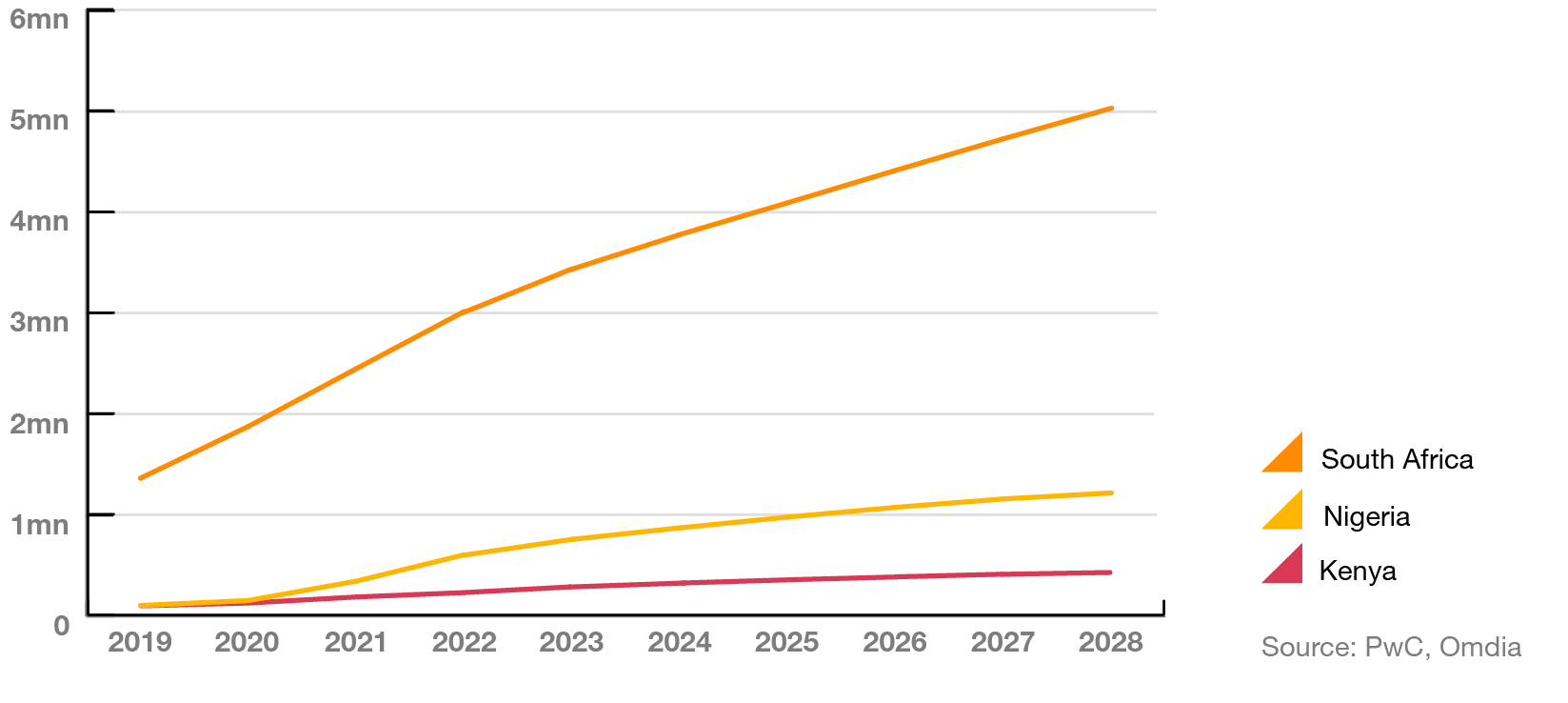
The OTT segment will continue to contribute to E&M revenue growth across the African continent. The South African market is set to grow at a 8.5% CAGR to produce revenue of R6.8bn (US$370mn) in 2028, up from R4.5bn (US$246mn) in 2023.
The OTT markets in Nigeria and Kenya remain comparatively small due to low broadband penetration. OTT revenue growth rates are however some of the highest seen across the various E&M segments for these markets. In Nigeria, total OTT revenue will grow at a 10.5% CAGR to reach US$107mn in 2028 (up from US$65mn in 2023), driven partly by major international streaming services partnering with local telcos and offering lower-cost, mobile-only plans to boost take-up. The Kenyan OTT market doubled in size in recent years and revenue is expected to further grow at a 10.9% CAGR to reach US$16mn in 2028.
At a global level, the forecast period will see streaming services grapple with maintaining profitability as the expense of content continues to increase. Key players have launched ad-supported tiers to mitigate some of these costs, but African markets have so far been excluded from these rollouts. Other strategies seen globally, however, such as password-sharing crackdowns in order to increase subscription bases, have been introduced in Africa. For example, Netflix implemented an account-sharing crackdown policy in South Africa in July 2023. Operators are also bundling services to reduce churn, with Disney+ launching a mobile-only tier in South Africa in 2023 with telco partner MTN, giving subscribers access to a 2GB subsidised data bundle.
Advertising
Growth in broadcast TV advertising revenue is slowing
Growth in broadcast TV advertising is expected to continue for all markets throughout the forecast period, but pressure from streaming services has slowed growth. While South Africa has a relatively well-established TV advertising market, Nigeria and Kenya’s markets are much smaller and are primed for greater growth as a result.
The slowdown in broadcast TV advertising spend is reflective of current global attitudes, where consumers have become less interested in watching traditional TV and are moving towards streaming platforms instead. However, linear TV still holds an appeal for ‘appointment TV’ and advertising peaks will still occur during major events including sports tournaments and elections.
Figure 6: Broadcast TV advertising revenue to total R6.9 bn in 2028
South Africa, broadcast TV advertising revenue (R bn) vs annual growth (%), 2019-2028
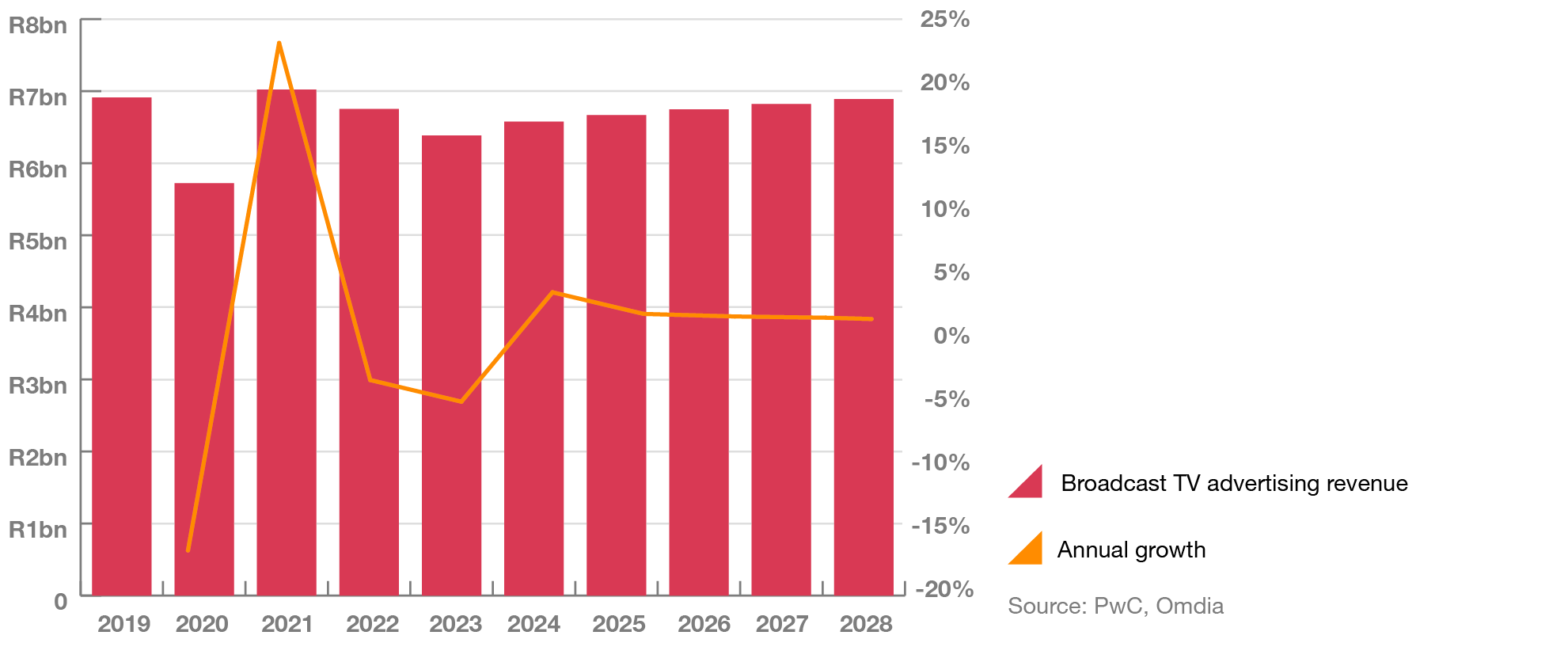
Connected TV advertising offers opportunities for future growth
While mobile penetration rates in Africa have risen rapidly over the past decade, supporting the growth of SVOD, the development of fully integrated TV services in Africa has been hampered by the relatively high cost of equipment and low broadband penetration levels in the region. Connected TV (CTV)² can be seen as a unifying medium of traditional linear TV and premium online video for broadcasters; however, its integration into the African broadcaster landscape is still a long way from materialising.
CTV will prove a welcome source of growth for an array of companies in entertainment and media – and beyond. The ability to serve addressable and measurable ads on TV screens will be key to streamers and local broadcasters looking to bolster the growth and profitability of their direct-to-consumer online video services. Revenue from advertising served on CTV screens in South Africa is set to more than double from R237mn (US$13mn) in 2023 to R682mn (US$37mn) in 2028.
Figure 7: Connected TV advertising will see huge growth to 2028
South Africa, connected TV advertising revenue split by type, 2019-2028 (R mn)
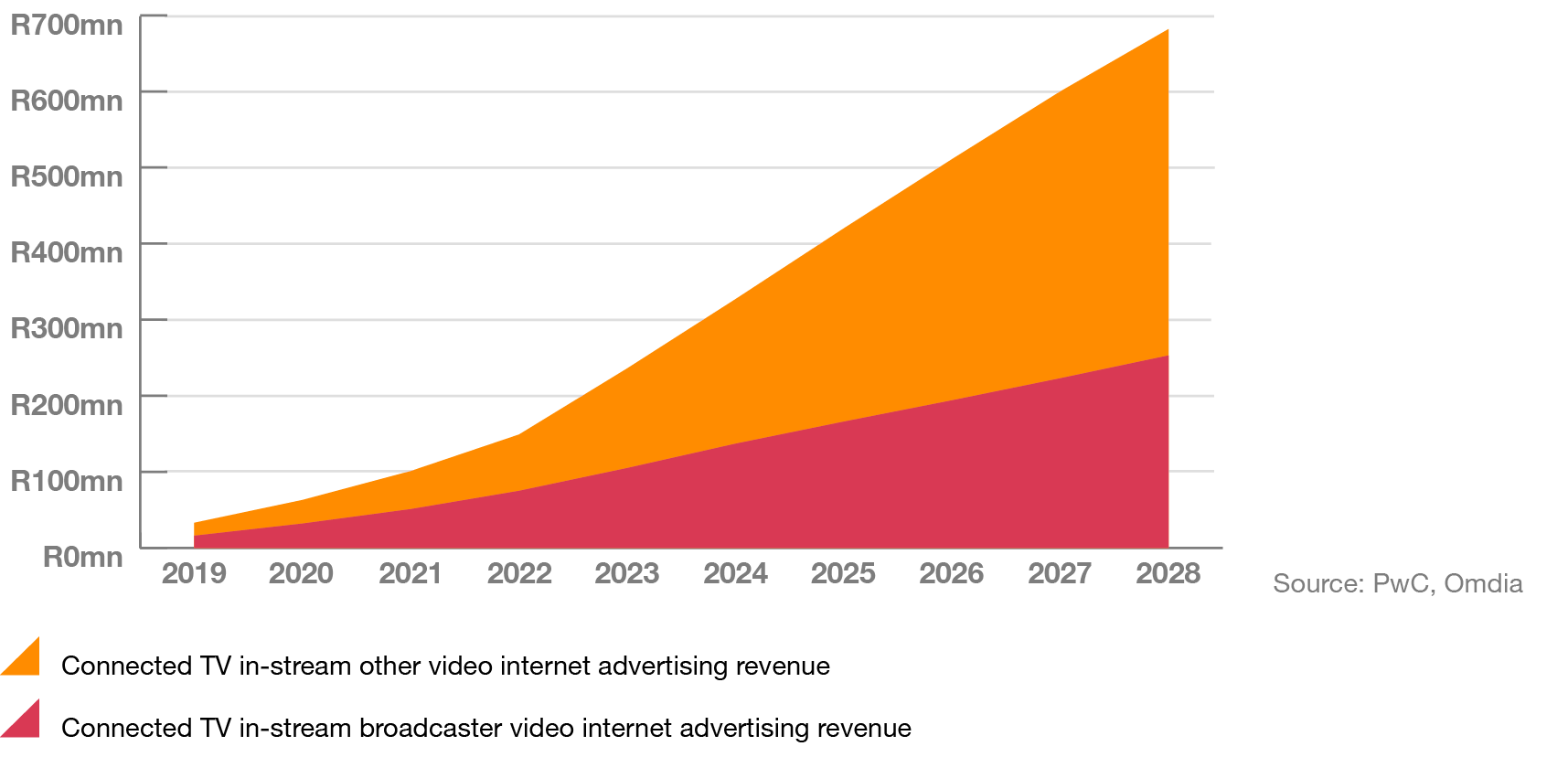
For the consumer electronics market, CTV advertising could be transformational. With thin margins on TV set sales, CTV advertising enables manufacturers to monetise their access to viewers, via their own online video offerings and by demanding shares of ad inventory on third-party apps on their platforms.
CTV sets have also been a key enabler of free ad-supported streaming TV (FAST). These broadcast TV-like services typically offer selections of pre-programmed online video channels, via an interface like a traditional TV electronic programme guide. Notably, FAST has been pioneered and popularised by startups and CTV manufacturers.
CTV advertising will also play a key role in the impact of retail media. This emerging opportunity centres on advertising on retailer websites and apps, usually by brands that sell products via those retailers. Its powerful promise to directly link purchases to such ads, known as closed-loop attribution, is central to its appeal.
Retail search and AI to influence internet advertising segment
At a global level, the internet advertising segment has accounted for the majority of ad spend for several years, accounting for 68.0% of total revenue in 2023. Both South Africa and Nigeria’s advertising sectors have also experienced this tipping point in recent years, as COVID-19 accelerated the development of the industry in these markets. Kenya, however, lags the global trend, with its advertising sector still featuring almost equivalent spend on the combination of radio and broadcast TV. But by 2026, internet advertising revenue in Kenya will have risen to US$286mn, supported by gains in the display and video sub-segments. At this point, internet ad revenue will overtake other formats and, in line with global trends, lead the country’s advertising sector.
Figure 8: Internet advertising segment to account for majority of Kenyan ad spend from 2026
Kenya, Internet advertising vs other advertising revenue, 2019-2023 (US$ mn)
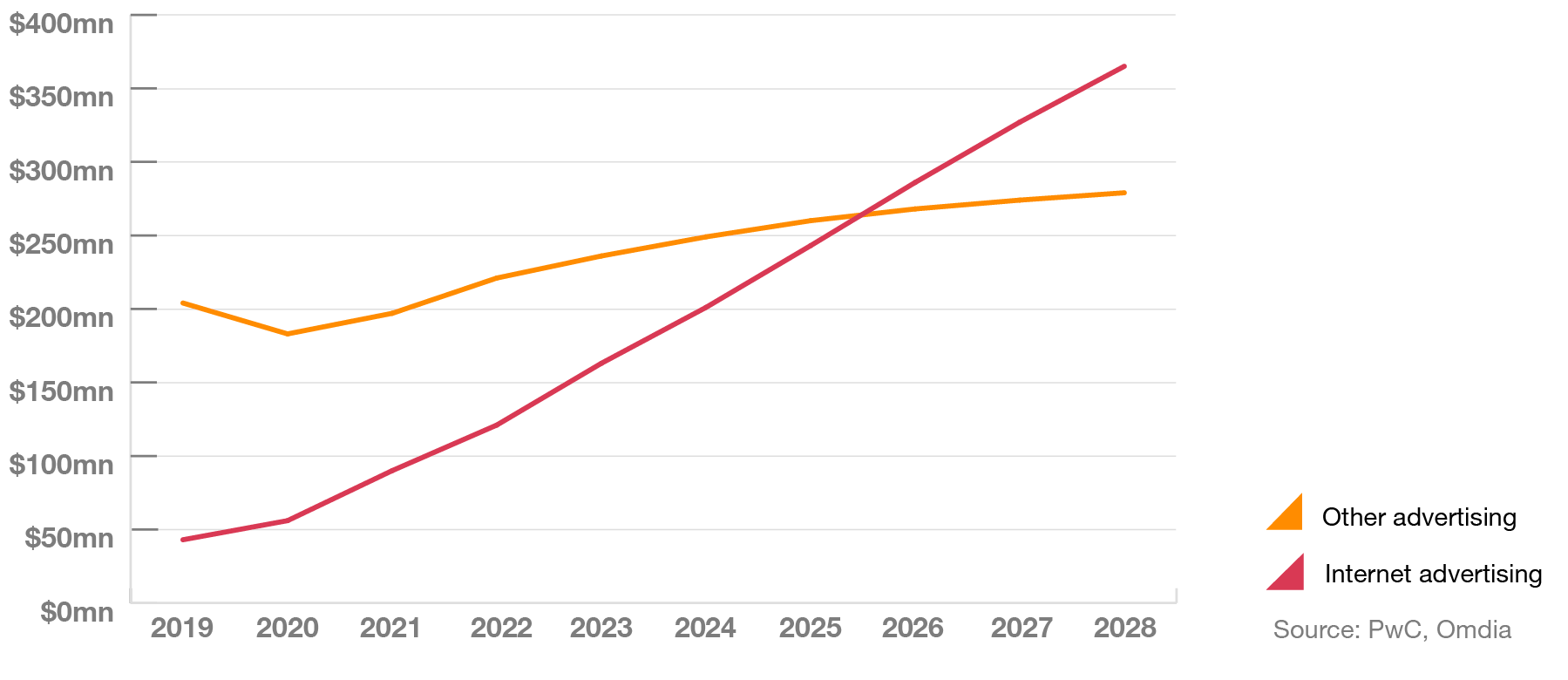
Like most markets globally, large, international tech companies are overwhelmingly the beneficiaries of internet advertising spend in Africa. In early 2024, the Competition Commission of South Africa held an inquiry into the dominance of big tech platforms in the market. According to data from PwC and South Africa’s Internet Advertising Bureau, Google accounted for 99.0% of paid search spend in South Africa in 2023.
Paid search advertising revenue across Kenya and Nigeria will rise rapidly over the forecast period, at a CAGR of 17.1% and 14.8% respectively. South Africa will also see healthy growth at a 9.4% CAGR expected over the forecast period. This growth will come despite the threat that genAI poses not only to traditional search ad formats, but also the way in which consumers search the internet in general. The biggest search advertising players have, however, actively moved to integrate AI into their core search platforms and to bolster the effectiveness of the ad campaigns they’re able to offer.
Another factor being considered by traditional search players globally is the rise of retail paid search, which comprises revenue generated from keyword-based search advertising delivered on retailer-owned sites and apps. This revenue accounts for over a third of total paid search spend globally, as product advertisers increasingly look to shorten the path from impressions to purchase and seek closed-loop attribution on sales.
In Africa, the development of retail search is largely nascent, with traditional paid search taking around 99.0% of all spend in both Kenya and South Africa. However, Nigeria’s sector is more advanced, with retail accounting for 27.3% of paid search revenue in 2023. The country is home to a strong e-commerce sector, led by players such as Jumia and Konga.
Expansion in e-commerce sales across the region will support retail media advertising growth, as will the launch of retail media networks being launched by retailers. Amazon is a driving force behind the segment’s expansion globally and launched in South Africa in May 2024.
Figure 9: African markets lag global retail search share
Global vs selected African markets, paid search advertising split by category, 2023 (%)
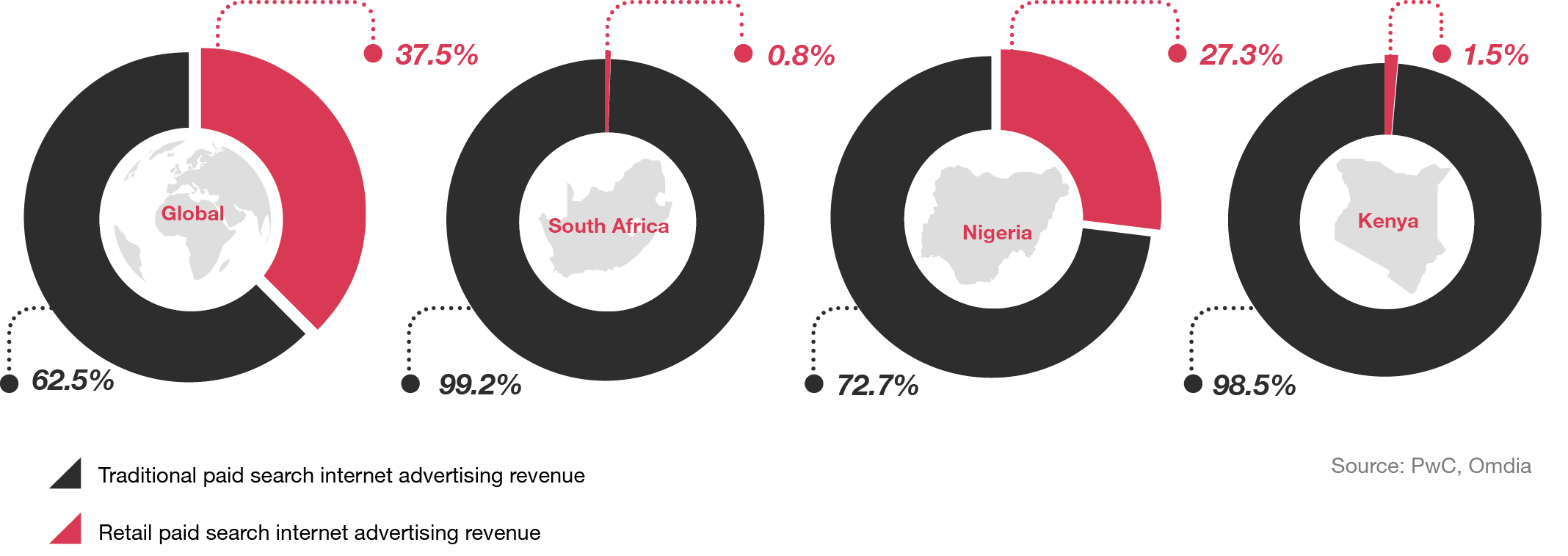
The only other digital revenue which falls outside of the internet advertising segment is digital out of home (DOOH) revenue. Revenue in South Africa was R1.1bn (US$59mn) in 2023 and the sector is expanding. In mid-2024, programmatic DOOH network Polygon announced that it would be expanding its offering to 11 other African markets, including Nigeria and Kenya.
Digital advertising took a 59.1% share of total ad revenue in South Africa in 2023 and will account for two-thirds of this spend in 2028.
Figure 10: Digital will comprise over two-thirds of ad spend in South Africa by 2028
South Africa, advertising spend split by digital and non-digital, 2019-2028 (%)
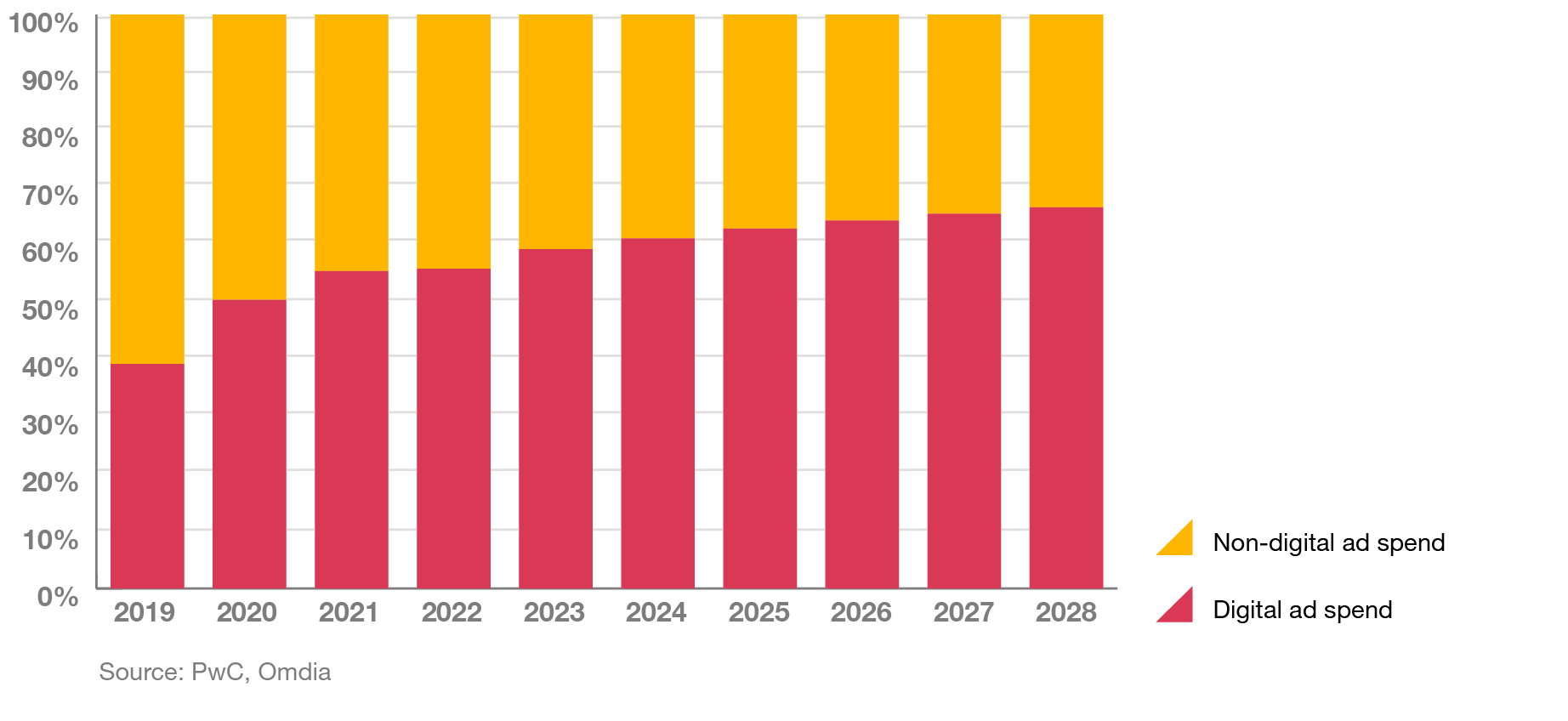
GenAI
AI set to have a significant impact in Africa
The explosion of genAI is set to affect a wide variety of industries globally over the coming years. As well as bringing significant opportunities, there are concerns over the long-term effect of AI on job markets, as well as the ethics of using AI. The power of genAI has the potential to disrupt many aspects of the media and entertainment industry. On the creative side, genAI can quickly and easily convert ideas into images, stories or scripts for use as the basis of further development or even final copy. Text-to-video or text-to-game models are showing promise for further acceleration of the production process.
AI can assist in analysing and categorising content and determine what users watch through content recommendation engines. AI-powered user analytics has the potential to enhance production choices. Technical advances such as network optimisation and image upscaling push down costs and improve user experience. Meanwhile, customer support is enhanced, with automated chatbots and voice response systems increasingly resolving user queries without costly in-person support.
Other regions have seen activity in AI usage specifically for E&M. For example, film studio Lionsgate and AI company Runway announced a partnership in September 2024. The partnership will allow the AI firm access to Lionsgate’s library of film and TV to train Runway’s genAI model.
In July 2024, the African Union Executive Council endorsed the Continental AI Strategy, which will help guide Africa’s AI development in a safe and responsible way. At the signing of the agreement, statistics revealed that Google had reported a 270% increase in the number of searches containing ‘AI’ on Google, while a reported 27% of Kenyans use ChatGPT daily.
In early 2024, Meta began testing its Meta AI chatbot in some African markets, including Nigeria. The feature was rolled out to a limited number of users of WhatsApp, Instagram and Messenger, with Meta confirming that its “AI-powered experiences are under development in varying phases”. The chatbot will provide customer service support to users and also enable them to create images.
Conclusion
The African E&M industry is poised for growth, driven by technological advancements, improved connectivity and increasing digital engagement. South Africa will remain the regional market leader in terms of scale, but Nigeria and Kenya will see faster growth, aided by young and growing populations and broader economic development.
Over the next five years, there will be broader uptake of internet packages, as well as increased government and enterprise investment in more reliable mobile and fixed infrastructure. This will underpin sector growth, as better connectivity will enable a wider pool of consumers to access E&M products and services and drive further engagement with those already online.
As Internet access expands, players will need to centre their business models around digital transformation. This will enable advertisers to increasingly leverage social media and mobile platforms to engage Africa’s young demographic. Personalised and data-driven advertising will become more prevalent, allowing for targeted campaigns that resonate with local audiences.
This digital shift will also support content production across sectors like OTT and music. A focus on content localisation and cultural representation will engage African consumers and reach new, global audiences. Moreover, the increasing interest and investment from international players highlights Africa’s growth potential.
Wider adoption of AI tools will enhance the way that content is produced, delivered and marketed. AI will transform the global E&M sector and its impact will be felt in Africa over the coming years. In the ever-dynamic E&M industry, resilience and reinvention will remain key to navigate challenges and unlock opportunities.
Reinventing the telco: Embracing a ‘puretone’ approach
The path towards business model reinvention starts with clear separation and focus for the array of models nested within an integrated telco.
Subscribe to the Outlook
Get 12 months of access to data and commentary for segments across 53 countries and territories, and access to dashboards and visualisations, including heat maps and comparisons of GDP and growth rates.
Contact us

Alinah Motaung-Tshabalala
Director | Africa Entertainment and Media Leader, PwC South Africa
Tel: +27 (0) 11 209 4874

Charles Stuart
Director | Entertainment and Media Specialist, PwC South Africa
Tel: +27 (0) 11 797 4223


Laolu Akindele
Director | Technology, Media and Telecommunications Leader, PwC Kenya
Tel: +254 (20) 285 5000

Nana Madikane
Director | Africa Technology, Media and Telecommunications Industry Leader, PwC South Africa
Tel: +27 (0) 11 797 5490







